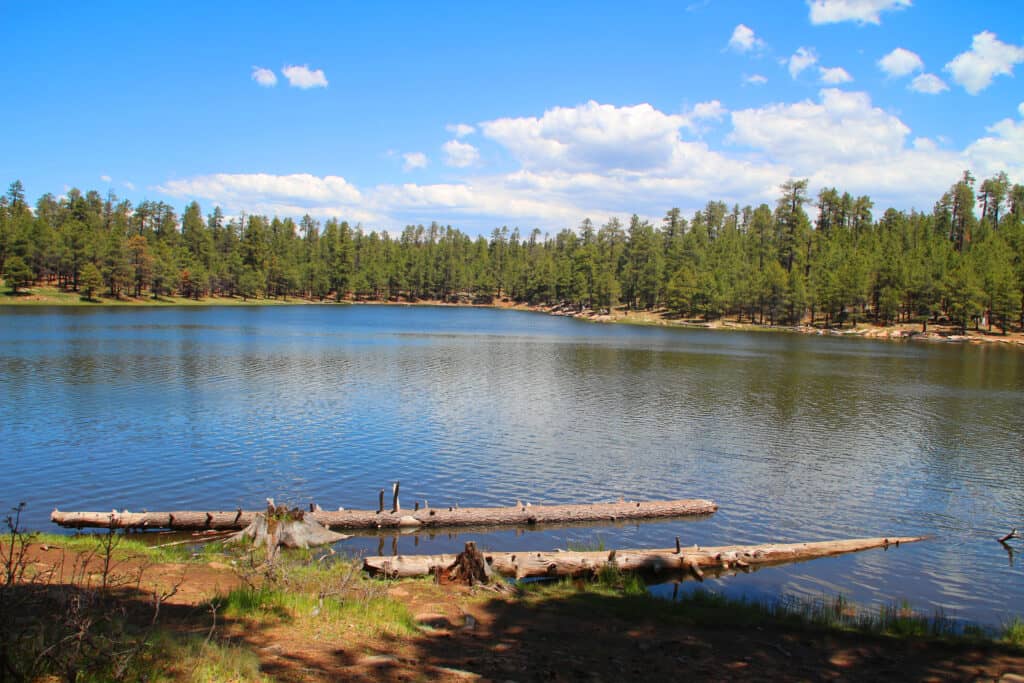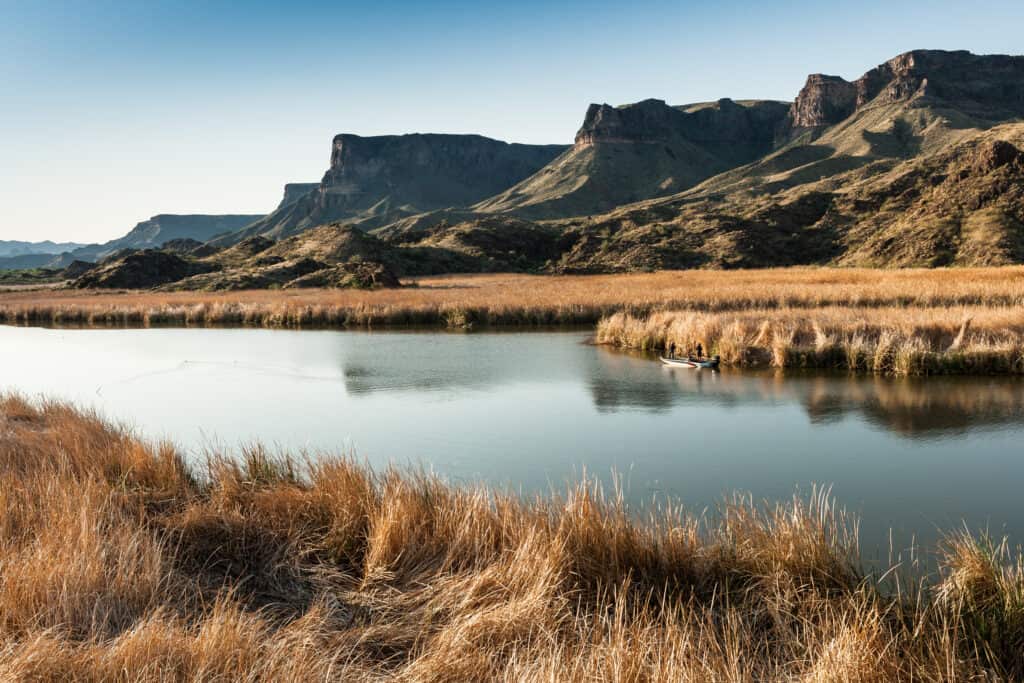The largest largemouth bass ever caught in Arizona was 16 lbs and 7.68 oz.
Arizona is located in the southwest corner of the United States, nestled in between California and New Mexico on its West and East sides, bordered by Nevada and Utah to the North and Mexico to the South.
Arizona is also famously home to the Grand Canyon, a 277-mile gorge that was formed by the rushing banks of the Colorado River. While the Grand Canyon or the state’s dry, arid climate are some of the first things that come to mind when most people think of Arizona, it is actually a great location for fishing.
The largemouth bass is one of the most popular fish in the state, second only to the longfin dace.
How Big was the Largest Largemouth Bass Ever Caught in Arizona and Where was it Caught?
The state record for the largest largemouth bass ever caught in Arizona was set by Randall E. White on April 22nd in 1997 at Canyon Lake along the Salt River, just 51 miles to the east of Phoenix. Canyon Lake is part of the Superstition Wilderness of Tonto National Forest, a beloved travel location for those who live in or are visiting Phoenix.
Canyon Lake is revered as the best spot for bass fishing in the Arizona Desert and is also home to a considerable selection of smallmouth bass, rainbow trout, yellow bass, channel and flathead catfish, black crappie, walleye, and bluegill.
There are three other lakes surrounding Canyon Lake (Apache Lake, Roosevelt Lake, and Saguaro Lake), all of which are larger, with the exception of Saguaro Lake. Canyon Lake is 10 miles long and has a surface area of 950 acres, an average depth of 130 feet, and a maximum depth of 141 feet.
Largemouth bass were originally only found in the Great Lakes, the Hudson Bay, along the St. Lawrence River, and in the Mississippi River basin. In 1897, they were brought to Arizona, where they are now one of the most popular species to fish for in the state.

©renzedyk/Shutterstock.com
How Many Kinds of Bass are in Arizona?
While largemouth bass are the most commonly fished-for bass in Arizona, there are many other kinds throughout the lakes and rivers of the state as well. In addition to the largemouth bass, there are smallmouth bass, yellow bass, white bass, and striped bass.
Smallmouth bass are similar to largemouth bass in that they can both be found in lakes and rivers, but there are significant differences between the two as well. Smallmouth bass tend to reach only 10 lbs, whereas largemouth bass regularly weigh up to 20 pounds and often grow longer, too. Smallmouth bass also prefer cooler waters and are most easily found in open water during the spring and fall months.
Another key distinction between the two can be found in their respective colors. Smallmouth bass are usually a lighter shade of brown whereas largemouth bass are varying degrees of green. One of the most obvious areas where these fish differ is in their mouth sizes. Largemouth bass have extended lower and upper jaws, but smallmouth bass have properly sized mouths when seen in relation to their bodies.

©iStock.com/stammphoto
Yellow bass are small fish with 5 to 7 striped rows along their body. The dorsal (or upper) part of the fish is olive green, but most of the body is yellow/silver in color. Young yellow bass are usually content on a diet of crustaceans and water insects, but once they have fully matured, they mainly eat other fish. They are endemic to Indiana, Tennessee, the Mississippi River basins, Lake Michigan, Alabama, Texas, Louisiana, Iowa, Wisconsin, Minnesota, and Oklahoma.
Yellow bass, like most fish, can only grow as big as their environment allows. These fish have a fast reproductive clip, so they tend to remain small as more and more of their species populate the habitat.
Yellow bass only live for 7 years, and (like largemouth bass) they congregate around aquatic structures, both natural and man-made, like docks, rocks, logs, and water reeds, for example, for shelter and to protect the schools they travel in. Most of the time, yellow bass can be found along rocky shorelines with depths of only two to three feet.
The white bass family is actually a misnomer, as these fish are usually anywhere from silver to pale green in color. They are sometimes also referred to as either silver bass or sand bass. White bass are carnivores that like to feed on crayfish, mayfly larvae, aquatic insects, and chironomid larvae. They grow to be around 10 to 12 inches long and prefer to populate open, slow-moving waters with warm temperatures. White bass typically only reach 5 lbs in weight, but some have been recorded at 7 lbs.
Striped bass can grow to be as much as 5 feet in length and up to 75 lbs or more. The more they mature, the more readily young striped bass will consume a diet of smaller crustaceans, larval fish, mayflies, and larvae. Upon reaching adulthood, striped bass become piscivorous and begin to eat fish, usually anything small and easily catchable. Adult striped bass have even been known to eat crabs, squid, and other small invertebrates.

©Mahler1780 / public domain – License
The lifespan of a fish is heavily dependent upon the temperature, size, and food supply of their habitat, but striped bass are recorded as living up to 30 years old. Usually, the female striped bass is ready to reproduce between age 4 and age 8, while the males reach sexual maturity at younger ages of 2 to 4 years old.
Striped bass can live easily in saltwater or freshwater, and is the state fish of New York, Virginia, New Hampshire, New Jersey, Rhode Island, South Carolina, and Maryland.
What are the Best Lakes for Largemouth Bass Fishing in Arizona?
Arizona is home to several lakes that are ideal for largemouth bass fishing, like Lake Mohave, Lake Havasu, Lake Roosevelt, Saguaro Lake, and Lake Martinez.
Lake Mohave is split between Arizona and Nevada and is regularly referred to as the top fishery of both states. The lake was named after the Mohave Indians who used to live in the Colorado River Valley. Lake Mohave extends for 67 miles, has a surface area of 41 miles, and has an average depth of 75 feet.
The water is famed for being unusually clear, making it easy to spot fish by sight in the spring months. While largemouth bass populate the lake, it is perhaps most famous for its wealth of smallmouth bass. Lake Mohave’s shoreline is full of cliffs, rocks, and various natural and man-made structures that both smallmouth and largemouth bass are known to congregate around.
Lake Havasu is another famous lake that anglers all over the country appreciate for its wide range of fish families. Bassmaster Magazine even included Lake Havasu in its list of the best lakes of the decade.
This lake was created between the years 1934 and 1938 and is split between Arizona and California, offering scenic views of the nearby Colorado River and Bill Williams River. It is a part of the Parker Dam, which has been undergoing extensive improvements starting in the 1990s, dramatically improving the fishing experience at Lake Havasu.
The most common types of bass it offers are largemouth, smallmouth, and striped bass, but the lake is also full of catfish, trout, panfish, many kinds of sunfish, carp, black crappie, and razorback suckers.
Lake Havasu is also well known for its bass fishing tournaments, such as the Lake Havasu Classic, the B.A.S.S. Nation Western Regional, and the Annual New Horizons Charity Pro-Am Bass Tournament.

©Laurens Hoddenbagh/Shutterstock.com
Lake Roosevelt (also known as Theodore Roosevelt Lake) has become more popular over the years as its water level has continued to rise. Much of its shoreline has now become submerged, providing underwater trees and bushes for the many kinds of fish that make the lake their home.
Lake Roosevelt is especially prized for its largemouth bass population but has also been known to host smallmouth bass up to 5 lbs in weight. The lake was created when Arizona built a masonry dam in 1911 on the Salt River, which makes it the oldest man-made reservoir in the state. At the time of its construction, it was the largest artificial lake in the world.
While the total length of Lake Roosevelt can change depending on whether or not it is in a drought year, it is predictably one of the largest lakes in Arizona at roughly 22 miles in length and a surface area of 21,493 acres. It’s second only to those that reside along the Colorado River.
Saguaro Lake was constructed as part of the Stewart Mountain Dam along the Salt River in 1930 and has an average depth of 90 feet with a surface area of 1,264 acres. Saguaro Lake has a 10-mile-long shoreline stocked with 12 species of fish and plenty of largemouth bass (imported from Florida), walleye, catfish, bigmouth buffalo, crappie, bluegill, yellow bass, and tilapia.
Bass up to twelve pounds have been caught a Saguaro Lake, and a thirty-pound carp was once discovered here as well. Many anglers hoping to catch trophy-level bass make their way to the lake in the months between February and April, or in late fall between October and December.
Saguaro Lake is located in the Tonto National Forest, which makes fishing at the water’s edge a wonderful experience with nature all around and on the horizon. The canyon walls of the Sonoran Desert are close by and, in combination with the desert cactus, they lend a rather picturesque feel to the environment.
Lake Martinez, also known as the Lower Colorado River, is right on the border of Arizona and Mexico. The lake is roughly 60 miles north of Yuma, and covers about 300 to 500 acres of surface area, depending on where you draw the border with the rest of the Colorado River.
While its average depth is only ten feet, Lake Martinez boasts an impressive array of fish, including largemouth bass, smallmouth bass, striped bass, carp, whiskerfish, tilapia, crappie, bullhead, channel, and flathead catfish, as well as redear, green, and bluegill sunfish. The lake was created as a small fishing community in 1958 and is largely a vacation destination today.
There are several smaller lakes nearby, like Hidden Shores, Ice Box, and Bullet Hole. Lake Martinez is also close to the Imperial National Wildlife Refuge, which means plenty of wildlife makes its way over to the area. There are plenty of artificial structures (logs, rocks, docks, and jetties) to find fish hiding in, and the Lake Martinez Recreation Facility ensures plenty of things to do year-round.
The photo featured at the top of this post is © Maclane Parker/Shutterstock.com
Thank you for reading! Have some feedback for us? Contact the AZ Animals editorial team.






